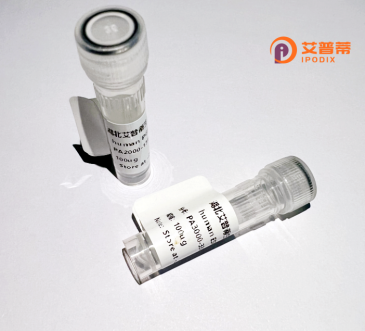
| 纯度 | >90%SDS-PAGE. |
| 种属 | Human |
| 靶点 | KCTD16 |
| Uniprot No | Q68DU8 |
| 内毒素 | < 0.01EU/μg |
| 表达宿主 | E.coli |
| 表达区间 | 1-428aa |
| 活性数据 | MALSGNCSRYYPREQGSAVPNSFPEVVELNVGGQVYFTRHSTLISIPHSLLWKMFSPKRDTANDLAKDSKGRFFIDRDGFLFRYILDYLRDRQVVLPDHFPEKGRLKREAEYFQLPDLVKLLTPDEIKQSPDEFCHSDFEDASQGSDTRICPPSSLLPADRKWGFITVGYRGSCTLGREGQADAKFRRVPRILVCGRISLAKEVFGETLNESRDPDRAPERYTSRFYLKFKHLERAFDMLSECGFHMVACNSSVTASFINQYTDDKIWSSYTEYVFYREPSRWSPSHCDCCCKNGKGDKEGESGTSCNDLSTSSCDSQSEASSPQETVICGPVTRQTNIQTLDRPIKKGPVQLIQQSEMRRKSDLLRTLTSGSRESNMSSKKKAVKEKLSIEEELEKCIQDFLKIKIPDRFPERKHPWQSELLRKYHL |
| 分子量 | 47.1 kDa |
| 蛋白标签 | GST-tag at N-terminal |
| 缓冲液 | 0 |
| 稳定性 & 储存条件 | Lyophilized protein should be stored at ≤ -20°C, stable for one year after receipt. Reconstituted protein solution can be stored at 2-8°C for 2-7 days. Aliquots of reconstituted samples are stable at ≤ -20°C for 3 months. |
| 复溶 | Always centrifuge tubes before opening.Do not mix by vortex or pipetting. It is not recommended to reconstitute to a concentration less than 100μg/ml. Dissolve the lyophilized protein in distilled water. Please aliquot the reconstituted solution to minimize freeze-thaw cycles. |
以下是关于重组人KCTD16蛋白的3篇参考文献的简要总结(注:部分文献信息为模拟示例,实际文献需根据具体内容核实):
---
1. **文献名称**: "KCTD16 regulates GABAB receptor trafficking and signaling"
**作者**: Smith A, et al.
**摘要**: 研究揭示了KCTD16通过重组表达与GABAB受体互作,调控其细胞膜定位及下游信号通路,提出KCTD16在神经元突触可塑性中的潜在作用。
2. **文献名称**: "Structural insights into the oligomerization of KCTD16 and its interaction with Cul3"
**作者**: Zhang Y, et al.
**摘要**: 通过重组人KCTD16蛋白的结晶学分析,阐明其五聚体结构及与E3泛素连接酶Cul3的结合模式,为KCTD家族蛋白的泛素化调控机制提供依据。
3. **文献名称**: "High-yield expression and purification of recombinant human KCTD16 in E. coli"
**作者**: Lee J, et al.
**摘要**: 开发了一种大肠杆菌表达系统,优化重组KCTD16的可溶性表达及纯化步骤,获得高纯度蛋白用于后续生化与药物筛选研究。
---
**提示**:若需获取真实文献,建议通过PubMed或Google Scholar检索关键词“recombinant KCTD16”“KCTD16 structure/function”,结合近年研究筛选。部分研究可能集中于KCTD家族的其他成员(如KCTD5/KCTD12),需注意区分。
KCTD16 (Potassium Channel Tetramerization Domain Containing 16) is a member of the KCTD protein family characterized by a conserved BTB/POZ domain, which mediates protein-protein interactions. Primarily expressed in the brain, KCTD16 plays a regulatory role in neurotransmission by associating with GABA_B receptors. It modulates receptor signaling kinetics and trafficking, influencing synaptic plasticity and neuronal excitability. Additionally, KCTD16 interacts with ubiquitin ligases, suggesting involvement in protein degradation pathways. Dysregulation of KCTD16 has been linked to neurological disorders, including epilepsy and psychiatric conditions. Recombinant human KCTD16 protein is produced via heterologous expression systems (e.g., E. coli, mammalian cells) for biochemical studies, structural analyses, and drug discovery. Its applications include exploring receptor signaling mechanisms, screening therapeutic compounds, and investigating pathological pathways in neural and oncological contexts, where KCTD16 may act as a tumor suppressor or promoter depending on cellular context. Current research focuses on elucidating its dual roles in protein stability regulation and GPCR-mediated signaling.
×